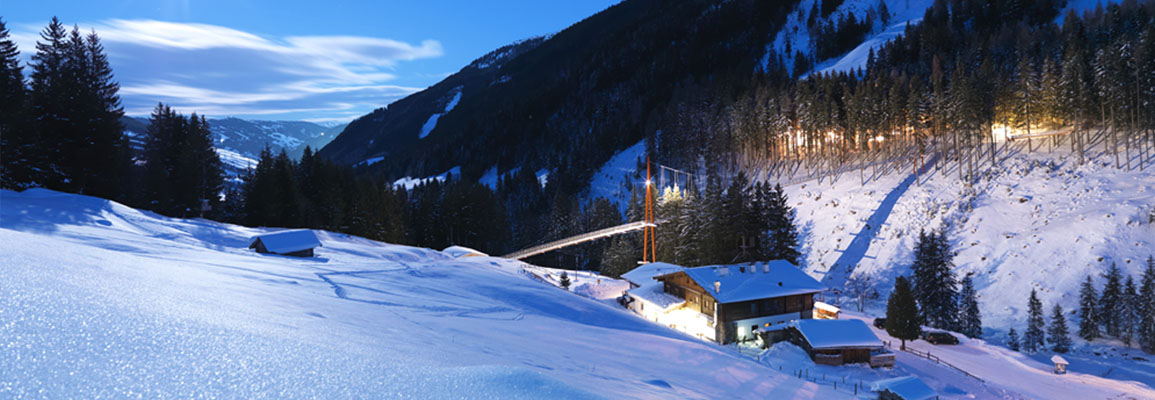Chasing the Moonlight in Saalbach, Austria

Austria is home to some of the most storied traditions of skiing the world over. It is a mountain culture that holds a deep passion for alpine sport and offers a host of peaks, valleys, and resorts in which to participate in the best that skiing has to offer.
Some time ago, I toured the area of Saalbach-Hinterglemm in the district of Zell am See. A close friend and his sister, who happened to be a guide, gave me a local tour of the wonderful off-piste skiing of the region. Downhill passions run deep in Saalbach: all traditions, including the après, are strongly connected to the culture of the area. One such tradition is good old-fashioned tobogganing; an adventurous way to complete the quintessential Saalbach ski experience and a uniquely Austrian means of après ski transport.
Austria, like the rest of Europe is very, very old and farmers in the Saalbach region have been working the land since the 1600’s. Many of those families left a legacy of beautiful farmhouses, which dot the mountains throughout the off-piste acreage of Saalbach. Traditional farming takes place during the summer, but in the winter, the farmhouses become bed & breakfasts catering to skiers and alpinists moving up and down the mountain at all hours of the day. During the après ski golden hour of the evening, warm meals and cold drinks are served to those hoping to stretch a day’s activities well into the night.
For these alpine farmers, transportation of their goods to market was facilitated by the construction of large toboggans. Although industrial transportation has since replaced this traditional means of transportation, the Austrians are not a culture to let a tradition fade. With the advent of skiing and its natural extension, après-ski, those same farmers now rent smaller versions of their original toboggans to their late night visitors as a means of making their way back to the village below via series of twisting and turning roads, stream beds, and groomed sledding trails.
Local tradition dictates that after the last daylight run of the day, Saalbach skiers will change into a set of warm, comfortable hiking clothes, and make their way under moonlight back to the farm houses which they had passed previously on their run down. These hikes often take an hour or two and wind upwards through valleys and frozen streams and provide a prelude of camaraderie before arriving at one of the quaint mountain top farm houses for consumption of Austrian food, drink, folk music, storytelling, laughter, and, ultimately, a traditional toboggan ride back down to the village below.
Obviously, even by moonlight, sitting tandem in an old wooden toboggan is not necessarily for the faint of heart. However, courage and hearty sustenance are provided in no short order by the farmhouse B&B’s as après skiers and hikers may choose from a menu of traditional Austrian dishes, beer, and schnapps. Two classic choices are Kasnocken and Kaiserschmarrn and if there was a last meal to be had before the perils of moonlit tobogganing, each dish would likely be at the top of any Austrian’s list. Kasnocken is a cheesey dumpling dish, combining sauteed onions, Pingauzer Birkaese cheese, and small flour dumplings. The dish is rich, dense, and delectable. When combined with an Austrian Pilsner, it's sure to create a greater weight for the toboggan ride to come.
And if Kasnocken is the salty dish of Austrian après ski, then Kaiserchmarrn is it sweet cousin. Effectively made like a pancake, this flat fluffy dough is then shredded and garnished with ice cream. Blueberries, and raspberries and topped further with powdered sugar. Served as a full meal, a dish of Kaiserchmarrn is often followed by a glass of schnapps. In fact, schnapps has been serving the same post-meal digestive purpose since it was first fermented hundreds of years ago when farmers, demanding a high calorie diet to keep up with a day’s labors also required a medicinal means of digesting such rich and sticky meals. Fortunately for the local Saalbach après crowd, the warmth and effect of the liquor is not meant to prepare one for tomorrow’s labors, but to fuel a bit of after-ski mischief and liquid courage for the toboggan ride to come.
Toboggans are rented by the brave of heart après skiers and hikers for a small charge of approximately five Euros, and because of the sense of freedom and personal accountability exuded throughout all mountain towns in Europe, there is no insurance form or red tape surrounding the myriad liabilities that might accompany such a transaction. Often après ski at the farmhouses at Saalbach bleed into the wee hours of the night, making the sledding a true test of skill and navigation. Riders are provided their sleds with a basic rope steering mechanism….and off they go! Locals tend to know their way around the mountain and the downhill portion of this Saalbach sledding experience offers a series of on-piste groomed trails which, when packed down firmly, can result in some hair-raising toboggan speeds. Off-piste adventures make their way back to the village below via frozen stream beds, which wind and twist their way to the bottom. Of course, what is such an experience without a few flails and falls?
Like any race, and a beer and schnapps fueled one at that, toboganneers jockey for position in a fun-filled descent under starry, wintry, Austrian nights. Toboggans slide and slip while laughter rings out in the cool, dark air. Riders switch toboggans, double-up for a few kilometers, and continue the playfulness that is the hallmark of winter recreation all the way to the base village where the day began with morning coffee, tea, and the wonderful expectations of a long day of skiing ahead. Most tourists have long since ended the day, their last run of the day well behind the local Saalbach tobogganeers chasing the moonlight back home to their beds.




